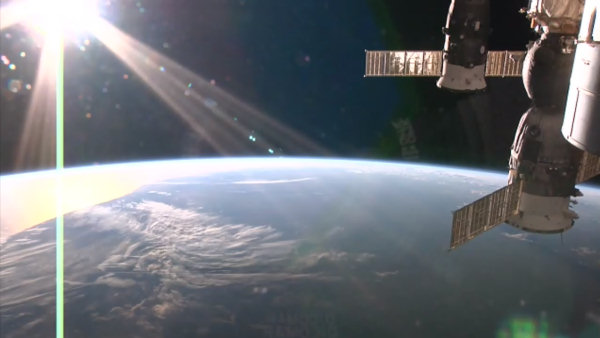 Tomorrow evening, a new group of astronauts will be launching into space to the International Space Station from the Baikonur Cosmodrome in Kasachstan. The second part of Expedition 40 will be the American Reid Wiseman, the Russian Maxim Surayev and the German Alexander Gerst – a truly international crew of three countries who may be at odds in the political world, but in space this does not matter at all.
Tomorrow evening, a new group of astronauts will be launching into space to the International Space Station from the Baikonur Cosmodrome in Kasachstan. The second part of Expedition 40 will be the American Reid Wiseman, the Russian Maxim Surayev and the German Alexander Gerst – a truly international crew of three countries who may be at odds in the political world, but in space this does not matter at all.
Tomorrow’s Soyuz launch will be at 21:56 CEST or 7:56pm UTC, with the docking scheduled for 04:14 CEST or 02:14am UTC. There is also going to be a special ESA post-launch hangout with Luca Parmitano from the Columbus control center at 22:30 CEST or 10:30pm UTC!
[Update 28.05.: The launch was a success! The three astronauts are in orbit and now have to catch up with the space station. Hopefully they can take the quick route and dock in six hours!]
[Update 29.05.: And they really did it in under six hours! Here are videos from the liftoff, the docking and the hatch opening and welcome ceremony. Now the real work and science begins!]
The mission of Alexander Gerst is, of course, of special interest to us since he is only the third German astronaut to visit the space station after Hans Schlegel and Thomas Reiter and only the second one on a long-term mission – but he is more an European to me in the same group as all other ESA astronauts. I especially love that Gerst has chosen to call his mission Blue Dot after the famous Voyager image and Carl Sagan’s subsequent description of it. I won’t even begin to write about the details of the mission, because today the ESA has uploaded a wonderful 40-page brochure about it, available in both English and German with a lot of information not only about Gerst, but the whole spaceflight experience to the ISS. It’s very well-written and has a lot of amazing photos and graphics, making it very much worth downloading and reading.
Alexander Gerst is also taking a mouse with him to space – an orange plush one, the mascot of the popular German children’s television show Die Sendung mit der Maus. It’s not the first spaceflight of the Maus – it had been on Mir in 1992 when German Astronaut Klaus-Dietrich Flade had taken it on a short visit and even filmed a segment for the program. Alexander Gerst has already appeared in Sunday’s broadcast, which you can still watch in a recording in the ARD Mediathek (in German of course). During his stay in space, he will be answering questions from children on the Maus Website which will probably get read out in the program – there is no word yet if he will be doing video recordings for them or even a live linkup, but maybe something will happen. I love this especially because Die Sendung mit der Maus was a part of my own childhood – the program originally began in 1971 and is older than me!
While he has an official blog on the ESA website, Alexander Gerst is also very active on Twitter as @Astro_Alex, where he has been constantly reporting about his preparations for his first spaceflight and has been posting a lot of photos recently. He is joined by Reid Wiseman at @Astro_Reid and, as I only found out yesterday, by Maksim Surayev at @MSuraev! The cosmonaut just started tweeting again a short while ago and is only posting in Russian – but this should not be a problem with online translation. [Update 31.05.: I keep finding more Russian astronauts on Twitter – Oleg Artemyev, who arrived on the station in March is also tweeting as @OlegMKS!]
The three astronauts of the prime crew have been actively supported by their backups, who will be going to space in November, Samantha Cristoforetti, Anton Shkaplerov and Terry Wirts with both Cristoforetti and Wirts posting many amazing photos from Baikonur on their Twitter streams @AstroSamantha and @AstroTerry. [Update: Shkaplerov is also on Twitter as @AntonAstrey, although he isn’t very active and mostly retweeting from his crewmates.] Cristoforetti is also still actively writing her Logbook on Google+ about her own preparations for her first spaceflght and two weeks ago she did a great ESA Hangout answering questions from all over the world!
If you want to follow all the astronauts on Twitter, I’m still maintaining and updating my Astronaut Twitter List – if you know of any astronauts or cosmonauts I don’t have in there, please don’t hesitate to tell me! With all the great social media involvement, the next year or so is certainly going to be amazing regarding all things spaceflight.
This year, for a change, I have not forgotten that it’s Towel Day today, the annual celebration of all things Douglas Adams and Hitchhiker’s Guide to the Galaxy. This time around, I managed to throw together a couple of things – head over to DVDLog to read the painstakingly translated review of the 1981 Hitchhiker’s Guide to the Galaxy televisison series, which was actually a lot of fun to revisit and update, because it’s not only a disc review, but partly the history of the Hitchhiker’s Guide itself. I originally wanted to make this a double review together with the 2005 movie, but that has to wait until next week or so because writing the translation took a bit longer than I expected!
Back in March, it seems I missed something great – the cast of the Hitchhiker’s Guide Radio Series had been on tour with a live show, but this spring there was a 75-minute live radio broadcast on BBC4 from the whole gang. And of course it’s now off the iPlayer and I haven’t found a recording of it yet – but hopefully it will materialize somewhere!
Meanwhile I’ve been poking around Youtube and there are some great Douglas Adams treasures out there, which I have put together in a little playlist. There are several great documentaries and even the rare South Bank show which I originally saw in dubbed version somewhen in the early 1990s on German television. You can actually find the television series itself somewhere if you search for it, but I’m not linking to it because the Youtube uploads have a really bad image quality compared to the DVD and, of course, because of copyright reasons. Buy the DVD! It’s not like it still costs 30 bucks like it did twelve years ago.
And there’s something which Douglas Adams would have really liked: ISS Expedition 42 is wishing everybody a happy Towel Day! Samantha Cristoforetti, Terry Wirts and Anton Shklaperov are standing here holding a towel in front of the very Soyuz capsule which will bring Maksim Surayev, Alexander Gerst and Reid Wiseman to the ISS in only three days – they are the backup crew and are currently together with them in Baikonur.
Have I forgotten something? Maybe, but I can just add it later here in a sneaky after-publishing-edit – I already added the previous paragraph shortly before posting. Happy Towel Day everyone! :-)
 Tonight, another mission to the International Space Station comes to an end and a new one with the round number 40 starts when Rick Mastracchio, Koichi Wakata and Mikhail Tyurin return to Earth and temporarily reduce the crew to only three people instead of the usual six. NASA Television will as usual broadcast everything with the undocking happening at 00:15 CEST.
Tonight, another mission to the International Space Station comes to an end and a new one with the round number 40 starts when Rick Mastracchio, Koichi Wakata and Mikhail Tyurin return to Earth and temporarily reduce the crew to only three people instead of the usual six. NASA Television will as usual broadcast everything with the undocking happening at 00:15 CEST.
The astronauts are already strapped in and the hatch to the Soyuz capsule has been closed now for a while. Mastracchio and Wakata have already sent goodbye tweets, but the American astronaut has already promised “post-flight fun” and handed the Twitter baton over to Alexander Gerst and Reid Wiseman, who are already reporting a lot about the preparations for their May 28th launch together with their Roscosmos colleague Maksim Surayev – no Twitter link here, since the Russian astronauts are sadly not doing any social media. Scratch that! I’ve since found out that Surayev does in fact regularly tweet as @Msuraev, but he writes in Russian, which is thanks to online translators not a big problem.
[Update: The astronauts are safely back on earth, everything went as smooth as a bumpy, rattling Soyuz re-entry can be. The NASA TV Youtube Channel has a long video from the landing site operations – the capsule actually landed upright and the astronauts had to be pulled out through the top with the help of a mobile gantry. This hasn’t happened for a long time, usually the capsules land on the side.]
With the departure of Mastraccio and Wakata, there is a sort of social media outage on the ISS at the moment, because the only American astronaut Steven Swanson does not have a Twitter account, but there is at least the official Instagram ISS stream, where occasionally photos from orbit get posted. But that will only last until the next three astronauts go up.
Meanwhile, the future of the ISS seems once again in limbo – originally, the Space Station was supposed to stay at least another decade, but now Russian officials are rattling their sabers and saying that they want to give up the cooperation in 2020. As a rule, I won’t comment on the political reasons, but as this comes not from Roscosmos, but Russian deputy prime minister Dmitry Rogozin, this is nothing more than playing politics with spaceflight and science, which is a really sad and stupid situation.
I’ve been watching the new ISS Earth live stream for over a week, but it seems that only now the mainstream press seems to have really noticed it, although Universe Today and a couple of other space-themed media outlets reported the news around May 1st. There seems to be a little confusion about the cameras – this is not the commercial UrtheCast system, which is still in closed beta, but a separate NASA project called the HDEV or High Definition Earth Viewing Experiment. Four different comercially available HD cameras have been put in a climate controlled, but basically otherwise unshielded housing and installed outside the ISS. One camera is looking forward, one down and two aft. The whole unit does not record anything on the station, but directly downlinks its stream to Earth.
While the stream is publicly available over the UStream website, the main reason for this project is to test how modern video cameras are fairing in space. Some parts of the systems were designed by high school students through the NASA Hunch program and student teams are also responsible for the operation of the cameras. One thing to remember when watching the stream is that it is really an experiment – the cameras are fixed and do not have any zoom or panning capability, but switch their views automatically. Of course, there is nothing to see when the ISS is flying over the night side of the earth because the cameras are not light-sensitive enough, but the sunsets and sunrises can be spectacular like in the screenshot above. The broadcast also sometimes has gaps because the bandwith-intensive video connection does not cover the entire globe – just wait a little when a grey screen is shown until the image comes back.
I recommend having a look at the ISSTracker website or the excellent Orbitron program to find out where the ISS currently is – there is hardly a delay in the broadcast so that the orbit indicator is very accurate and can help predict when the station is on the night side of the planet. The bottom line is simply that the views are absolutely gorgeous and while there has been live streaming from the ISS before, this is the very first time that live video from the space station is available in really good quality. Welcome to the future :-).
 If you are, like me, using the Google Chrome browser under Windows XP with Servicepack 2 installed, you were in for a surprise a couple of weeks ago: the browser refused to make a SSL connection to Twitter, Dropbox, Pinterest, WordPress.com and a few other websites, complaining about a malformed SSL certificate. This is not a virus attack or something malicious - it actually happens because Twitter.com got a new SSL certificate signed with SHA-256 on April 7th which seems to be incompatible with Windows XP SP2, the other websites seem to have similar new certificates. Chrome uses Windows' built-in SSL certificate management, which does not support SHA-256 until Servicepack 3. All browsers using Webkit/Blink seem to be affected plus, of course, the Internet Explorer, but not Firefox or the older Opera versions up to 12 because they use their own certificate management.
If you are, like me, using the Google Chrome browser under Windows XP with Servicepack 2 installed, you were in for a surprise a couple of weeks ago: the browser refused to make a SSL connection to Twitter, Dropbox, Pinterest, WordPress.com and a few other websites, complaining about a malformed SSL certificate. This is not a virus attack or something malicious - it actually happens because Twitter.com got a new SSL certificate signed with SHA-256 on April 7th which seems to be incompatible with Windows XP SP2, the other websites seem to have similar new certificates. Chrome uses Windows' built-in SSL certificate management, which does not support SHA-256 until Servicepack 3. All browsers using Webkit/Blink seem to be affected plus, of course, the Internet Explorer, but not Firefox or the older Opera versions up to 12 because they use their own certificate management.
As far as I have found out, there is no way to fix this problem for Chrome under Windows XP without upgrading to Servicepack 3, which may be a huge problem for users with low harddisk space or programs which do not work well under SP3. But there is a way to override the message and still use Twitter with Chrome despite the malformed certificate: you have to add the command line option --ignore-certificate-errors to the shortcut on your desktop or start menu after the chrome.exe command. This overrides the message and loads the websites, but you still get the red crossed-out warning in the address bar. The main problem is that Chrome does not appear to have any other way to overrite the certificate warnings.
[Update July 1st: Since version 35, Chrome is displaying a warning message on startup that the --ignore-certificate-errors command line option is unsupported, but the fix is still working as described. Hopefully Google is not going to remove the option completely! August 28th: Still works with the latest update to version 37!]
Please note that this might be dangerous! While a website still seems to be properly encrypted with the malformed certificate, I have no idea what effects this might have. Rumours that the encryption itself does not work without the certificate seem to be wrong, but be careful if you are on SSL-encrypted websites other than Twitter, Dropbox, Pinterest or WordPress.com and the crossed-out warning on the https://-prefix shows up! You can always click on the lock icon and find out what is going on. The mobile Twitter site at mobile.twitter.com is not affected by this problem, possibly because of a separate certificate.
I know that this is not an ideal solution, but it might be the only way to continue using Chrome on Windows XP SP2 systems.

